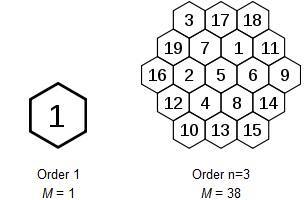Magic Hexagon

Most of us are familiar with Magic Squares and its wonders. But little is known about Magic Hexagons. This post is attributed for describing "Magic Hexagons".
A magic hexagon of order n is an arrangement of numbers in a centered hexagonal pattern with n cells on each edge, in such a way that the numbers in each row, in all three directions, sum to the same magic constant. A normal magic hexagon contains the consecutive integers from 1 to 3n^2 − 3n + 1. It turns out that normal magic hexagons exist only for n = 1 (which is trivial) and n = 3. Moreover, the solution of order 3 is essentially unique. These hexagons are shown for your reference. The first magic hexagon has Magic sum 1 and second has Magic Sum 38.
Easy Math Editor
This discussion board is a place to discuss our Daily Challenges and the math and science related to those challenges. Explanations are more than just a solution — they should explain the steps and thinking strategies that you used to obtain the solution. Comments should further the discussion of math and science.
When posting on Brilliant:
*italics*or_italics_**bold**or__bold__paragraph 1
paragraph 2
[example link](https://brilliant.org)> This is a quote# I indented these lines # 4 spaces, and now they show # up as a code block. print "hello world"\(...\)or\[...\]to ensure proper formatting.2 \times 32^{34}a_{i-1}\frac{2}{3}\sqrt{2}\sum_{i=1}^3\sin \theta\boxed{123}Comments
This is interesting. Do you know why no other magic hexagon of higher orders exist?
With n=2, why can't we have
5164273
The entries in each row sum to 12. Is there something that I'm missing?
Log in to reply
I believe what you wrote down isn't exactly correct. Although a few of the rows sum to 12, not all of them do. I'll go through a few of the rows.
1+2=12
5+6=12
6+7=12
and so on.
Log in to reply
Ah, even 'partial' rows count. That makes sense now. Thanks!
Higher order magic hexagons do exist, but cannot be 'normal'.